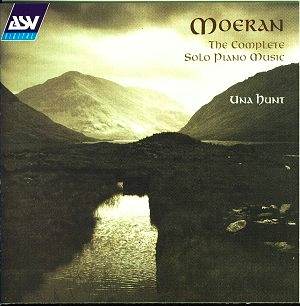Moeran’s published solo piano music - some eighteen
single pieces, of which only one (Theme and Variations) employs
an extended, larger-scale structure - was nearly all written during
the earlier part of his compositional career, between 1919 and 1927
i.e.between the ages of twenty-five and thirty-three, with his greatest
music yet to come. Only the short Two Pieces of 1933 were to
follow, wistfully elegiac and written in the wake of his friend Peter
Warlock’s tragic death in 1931.
This music must be heard and assessed in the context
of Moeran’s first achieved style: that of the early orchestral Rhapsodies,
the Norfolk folksong arrangements, the Piano Trio, the A minor String
Quartet and the grimly powerful Violin Sonata. In other words, beneath
the lyrically illustrative, romantic-impressionist surface of much of
the music, imbued as it is with a palpable spirit of place - Norfolk
waterways (Stalham River), the west of Ireland (Three Piano
Pieces), Herefordshire border country (Summer Valley), even
London perhaps on a summer holiday (Bank Holiday) - can run a
deeper, darker current of both personal feeling (Elegy) and Celtic
atavism to match anything in John Ireland or Arthur Machen (the remarkable
Rune). Threaded somewhere in virtually all these pieces, whatever
the setting, is a rich vein of folksong-inspired melody (always Moeran’s
own, except for the two folksong arrangements, the beautiful Irish
Love Song and The White Mountain) of either East-Anglian
or Irish provenance, informing the texture of even the most abstract
of titles (Theme and Variations, Toccata). There is indeed
more variety here - of mood, texture, and intent - than we might at
first expect, given Moeran’s relative youth at the time of composition,
and the comparative unimportance of his piano music within the wider
context of his life’s work.
A memorable collection then, of real musical appeal:
it takes a rightful, if lesser, place within the corpus of early twentieth
century British piano literature represented most outstandingly by Ireland,
Bridge and Bax. One important indication of its appeal is surely the
fact that the CD under review represents the third recording label to
have issued a complete cycle of Moeran’s piano music, which fits most
conveniently onto a single CD of just under eighty minutes. The first
such cycle was published over two LPs by Lyrita, with honours shared
between Iris Loveridge in 1960 (mono only) and Eric Parkin in 1972 (neither
recording is currently available). Then in 1994, the Moeran centenary
year, came Eric Parkin’s second, this time complete, recording for J.
Martin Stafford (JMSCD2 - available direct, for £12.50 inc. postage,
from the publisher at 298 Blossomfield Rd, Solihull B91 1TH). And now
appears the third recording, produced in Ireland for ASV, which has
already in its catalogue one of the most outstanding and essential of
all Moeran recordings: the Vanbrugh Quartet’s performance of the two
String Quartets and Fantasy-Quartet coupled with the Joachim Trio’s
performance of the Piano Trio (CD DCA 1045).
Those of us who possess the Loveridge LP (Lyrita RCS3)
should not consider discarding it, for - though sadly not a complete
survey, and recorded in now less-than-ideal sound - it possesses qualities
of fluent, unselfconscious technique and artistry which are not easily
replaced. This is playing of a sensitivity which takes the listener
through and beyond the notes to the underlying poetic impulse of each
piece: see with the mind’s eye as we listen.
Both Eric Parkin and Una Hunt also reveal qualities
of interpretative insight which are essential to this music. Parkin’s
earlier recording (Lyrita SRCS42) is generally the preferable of his
two, at least where performances are duplicated: one senses he is not
always playing fully up to the mark in the more recent Stafford CD.
Una Hunt plays with appealing clarity and understanding,
though there are areas of imaginative depth in some of this music which
she has yet fully to explore. But the balance is finally tipped in her
favour by dint of the recorded sound quality she is offered: warm, up-front
and embracing. This is a beautifully engineered disc, which admirably
projects the fine qualities of Hunt’s performance. Strongly recommended.
John Talbot
THIS REVIEW APPEARS HERE COURTESY
OF THE BRITISH MUSIC SOCIETY
British Music Society
- Promoters of the British Musical Heritage
Membership enquiries to:
Hon. Treasurer: Stephen Trowell
7 Tudor Gardens
Upminster
Essex RM14 3DE
( 01708 224795
Annual subscription £18.00 (UK residents only)
Patron £25.00 (minimum) (UK residents only)
All membership applications welcome. Enquiries from those outside the
UK are particularly invited. An approach should be made to Stephen Trowell.
